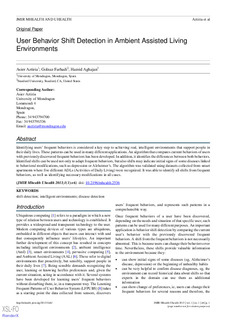Izenburua
User behavior shift detection in ambient assisted living environmentsEgilea
Beste instituzio
Stanford UniversityBertsioa
Bertsio argitaratua
Eskubideak
© Asier Aztiria, Golnaz Farhadi, Hamid Aghajan. Originally published in JMIR mHealth and uHealth (http://mhealth.jmir.org), 18.06.2013.Sarbidea
Sarbide irekiaArgitaratzailearen bertsioa
http://dx.doi.org/10.2196/mhealth.2536Non argitaratua
JMIR Mhealth Uhealth Vol. 1. Nº 1. e6,Argitaratzailea
JMIR PublicationsGako-hitzak
shift detectionintelligent environments
disease detection
Laburpena
Identifying users' frequent behaviors is considered a key step to achieving real, intelligent environments that support people in their daily lives. These patterns can be used in many different applic ... [+]
Identifying users' frequent behaviors is considered a key step to achieving real, intelligent environments that support people in their daily lives. These patterns can be used in many different applications. An algorithm that compares current behaviors of users with previously discovered frequent behaviors has been developed. In addition, it identifies the differences between both behaviors. Identified shifts can be used not only to adapt frequent behaviors, but also shifts may indicate initial signs of some diseases linked to behavioral modifications, such as depression or Alzheimer’s. The algorithm was validated using datasets collected from smart apartments where five different ADLs (Activities of Daily Living) were recognized. It was able to identify all shifts from frequent behaviors, as well as identifying necessary modifications in all cases. [-]
Bildumak
Item honek honako baimen-fitxategi hauek dauzka asoziatuta:






















